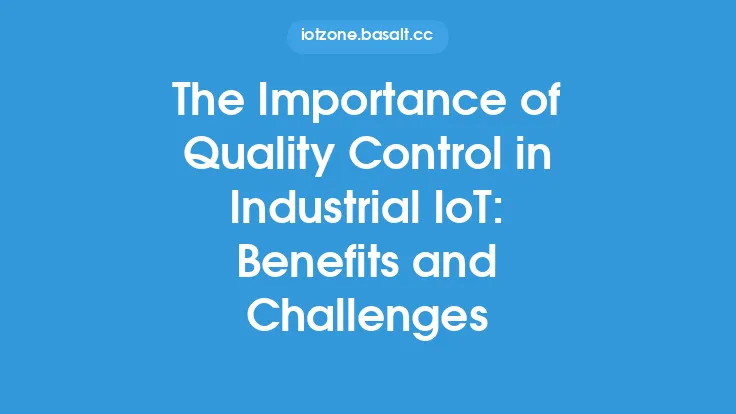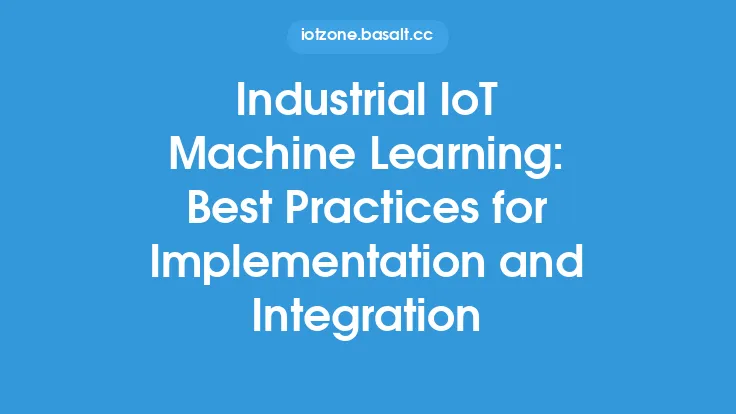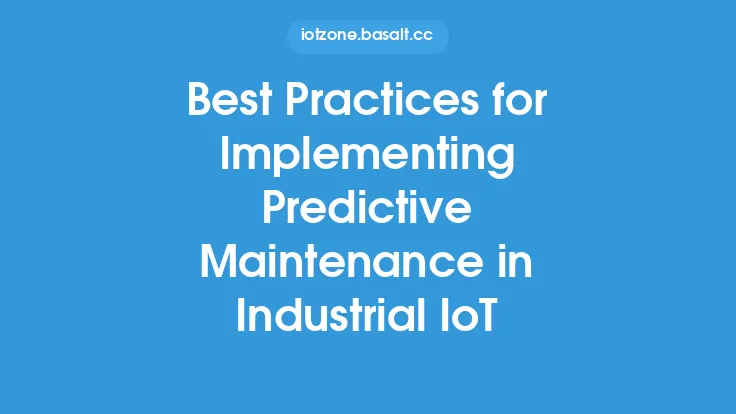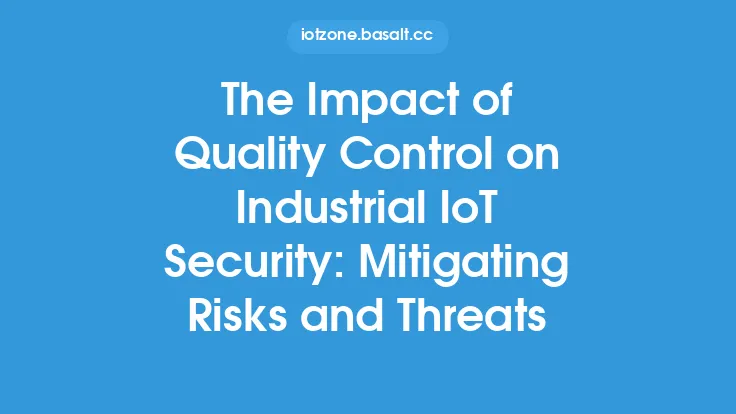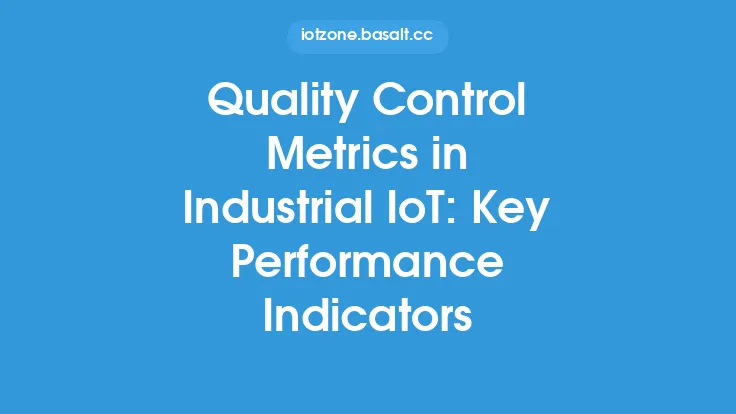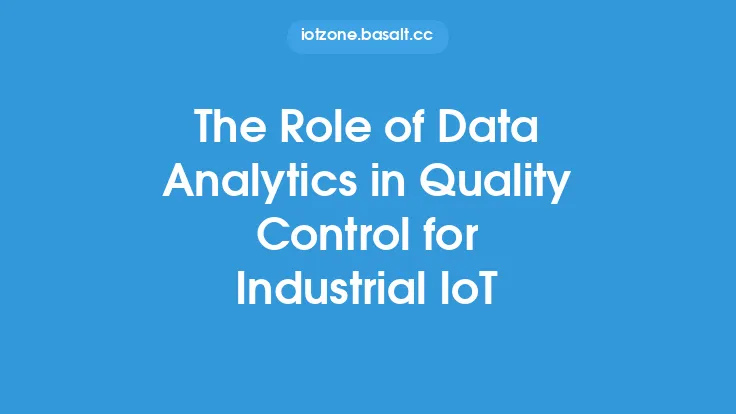Implementing quality control in Industrial IoT (IIoT) is crucial for ensuring the reliability, efficiency, and productivity of industrial operations. Quality control in IIoT involves monitoring and controlling the quality of products, processes, and systems in real-time, using data analytics, machine learning, and other advanced technologies. In this article, we will discuss the best practices and strategies for implementing quality control in IIoT, focusing on the technical and practical aspects of quality control.
Introduction to Quality Control in IIoT
Quality control in IIoT is a critical component of industrial operations, as it enables manufacturers to detect and prevent defects, reduce waste, and improve product quality. IIoT quality control involves the use of sensors, actuators, and other devices to collect data on product and process parameters, such as temperature, pressure, and vibration. This data is then analyzed using advanced analytics and machine learning algorithms to identify trends, patterns, and anomalies, and to predict potential quality issues.
Best Practices for Implementing Quality Control in IIoT
To implement effective quality control in IIoT, manufacturers should follow several best practices. First, they should define clear quality control objectives and metrics, such as defect rates, yield, and throughput. Second, they should implement a robust data collection and analytics infrastructure, including sensors, data storage, and analytics software. Third, they should use machine learning and other advanced analytics techniques to identify patterns and trends in the data, and to predict potential quality issues. Finally, they should establish a culture of continuous improvement, using quality control data and analytics to identify areas for improvement and to implement changes.
Quality Control Strategies for IIoT
There are several quality control strategies that manufacturers can use in IIoT, including preventive maintenance, predictive maintenance, and total productive maintenance (TPM). Preventive maintenance involves scheduling regular maintenance activities, such as cleaning and lubrication, to prevent equipment failures and reduce downtime. Predictive maintenance involves using data analytics and machine learning to predict when equipment is likely to fail, and to schedule maintenance activities accordingly. TPM involves using a combination of preventive and predictive maintenance, as well as other techniques, such as root cause analysis and failure mode and effects analysis (FMEA), to optimize equipment performance and reduce downtime.
Technical Requirements for IIoT Quality Control
To implement effective quality control in IIoT, manufacturers must have a robust technical infrastructure in place. This includes sensors and other data collection devices, data storage and analytics software, and communication networks and protocols. The technical infrastructure should be designed to support real-time data collection and analysis, as well as machine learning and other advanced analytics techniques. Additionally, the infrastructure should be scalable, flexible, and secure, to support the needs of the manufacturing operation.
Data Analytics for IIoT Quality Control
Data analytics is a critical component of IIoT quality control, as it enables manufacturers to extract insights and meaning from the large amounts of data collected from sensors and other devices. There are several types of data analytics that can be used in IIoT quality control, including descriptive analytics, diagnostic analytics, predictive analytics, and prescriptive analytics. Descriptive analytics involves using data to describe what has happened, such as defect rates and yield. Diagnostic analytics involves using data to identify the root causes of problems, such as equipment failures and process variations. Predictive analytics involves using data to predict what is likely to happen, such as equipment failures and quality issues. Prescriptive analytics involves using data to recommend actions, such as maintenance activities and process changes.
Machine Learning for IIoT Quality Control
Machine learning is a type of advanced analytics that can be used in IIoT quality control to identify patterns and trends in data, and to predict potential quality issues. There are several types of machine learning algorithms that can be used in IIoT quality control, including supervised learning, unsupervised learning, and reinforcement learning. Supervised learning involves training a model on labeled data, such as defect rates and yield, to predict future outcomes. Unsupervised learning involves using algorithms to identify patterns and trends in unlabeled data, such as sensor readings and process parameters. Reinforcement learning involves using algorithms to recommend actions, such as maintenance activities and process changes, based on rewards or penalties.
Implementation Roadmap for IIoT Quality Control
To implement effective quality control in IIoT, manufacturers should follow a structured implementation roadmap. This should include defining quality control objectives and metrics, implementing a data collection and analytics infrastructure, developing and deploying machine learning models, and establishing a culture of continuous improvement. The implementation roadmap should also include plans for training and supporting personnel, as well as for monitoring and evaluating the effectiveness of the quality control system.
Challenges and Limitations of IIoT Quality Control
There are several challenges and limitations to implementing effective quality control in IIoT, including data quality and integrity, cybersecurity, and scalability. Data quality and integrity are critical to effective quality control, as poor data quality can lead to inaccurate or misleading insights. Cybersecurity is also a critical concern, as IIoT systems can be vulnerable to cyber threats and attacks. Scalability is another challenge, as IIoT quality control systems must be able to support large amounts of data and complex analytics.
Conclusion
Implementing quality control in IIoT is a complex and challenging task, requiring a deep understanding of industrial operations, data analytics, and machine learning. By following best practices and strategies, such as defining clear quality control objectives and metrics, implementing a robust data collection and analytics infrastructure, and using machine learning and other advanced analytics techniques, manufacturers can improve product quality, reduce waste, and increase efficiency. However, there are also challenges and limitations to implementing effective quality control in IIoT, including data quality and integrity, cybersecurity, and scalability. By understanding these challenges and limitations, manufacturers can develop effective strategies for overcoming them, and for achieving the full benefits of IIoT quality control.
